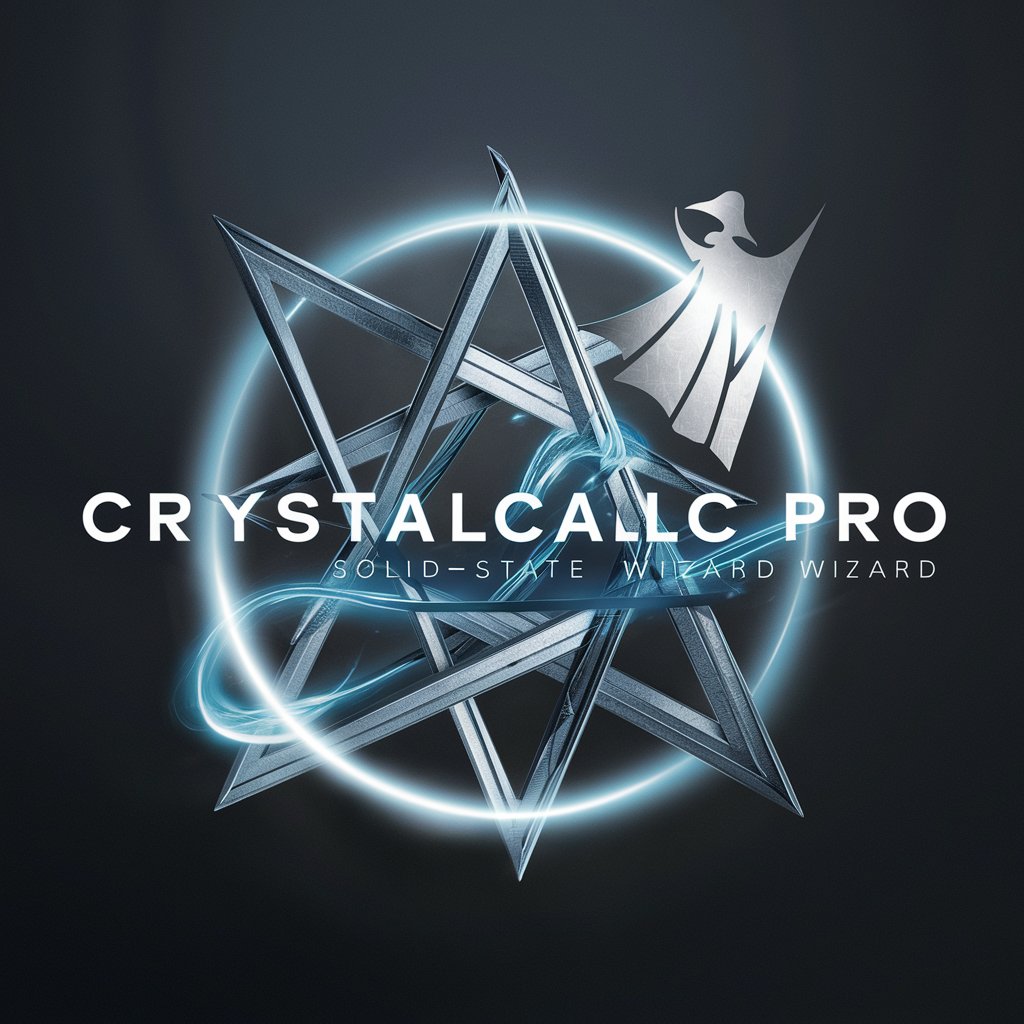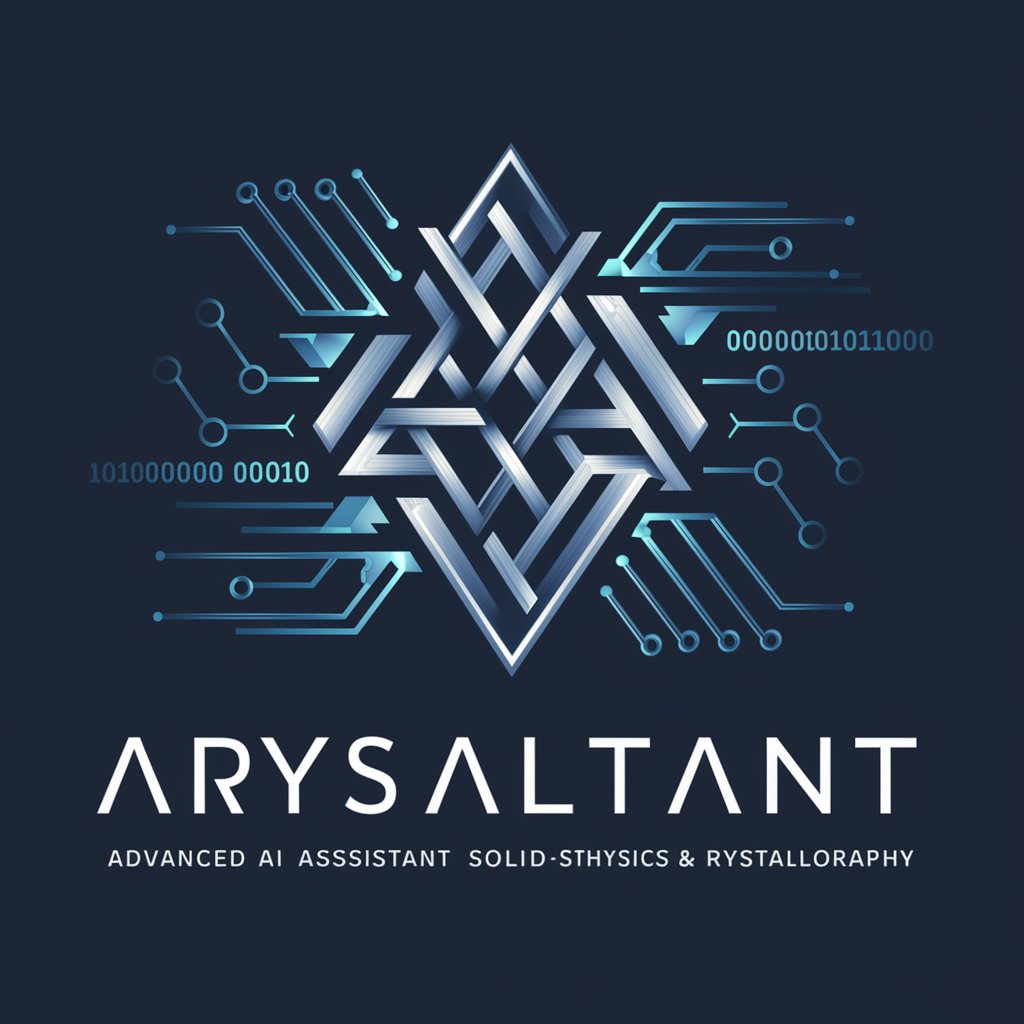
🔮 CrystalCalc Pro: Solid-State Wizard - Crystallography AI Analysis

Welcome to CrystalCalc Pro, your guide to crystallography and solid-state physics.
Empowering research with AI-driven crystallography insights
Explain the process of X-ray diffraction and its application in crystallography.
How do you calculate the lattice parameters for a given crystal structure?
Describe the differences between FCC, BCC, and HCP lattice structures.
Can you help me interpret the results of my recent spectroscopic analysis?
Get Embed Code
Overview of CrystalCalc Pro: Solid-State Wizard
CrystalCalc Pro: Solid-State Wizard is a specialized GPT tailored for the fields of crystallography and solid-state physics. Its design purpose is to support researchers, educators, and students in these scientific domains by offering detailed explanations, calculations, and data analysis tools. This GPT can simulate crystallographic models, elucidate band theory, compute cell parameters, and assist in the interpretation of spectroscopic data. It is equipped to provide insights on lattice structures, explain X-ray diffraction techniques, and offer guidance on material properties and research methodologies. For example, it can help in analyzing the crystal structure of a new material by simulating its X-ray diffraction pattern or computing its lattice parameters based on experimental data. Powered by ChatGPT-4o。

Core Functions and Applications
Simulation of Crystallographic Models
Example
Simulating the 3D structure of a crystal lattice for educational purposes.
Scenario
A researcher wants to understand the crystal structure of a novel compound. Using this GPT, they can generate a detailed 3D model of the compound's lattice, aiding in visualization and further analysis.
X-ray Diffraction Analysis
Example
Analyzing diffraction patterns to determine crystal structures.
Scenario
A student is working on a project to identify the crystal structure of an unknown mineral. They use CrystalCalc Pro to interpret X-ray diffraction data, which helps them identify the mineral's crystal system and lattice parameters.
Band Theory Explanations
Example
Explaining the electronic structure of solids to predict material properties.
Scenario
An educator is preparing a lecture on the electrical conductivity of semiconductors. They utilize CrystalCalc Pro to generate clear, detailed explanations of band theory, enhancing the learning experience for their students.
Materials Property Insights
Example
Providing insights on the mechanical, thermal, and electronic properties of materials.
Scenario
A company is developing a new alloy for high-temperature applications. They consult CrystalCalc Pro to understand the material's thermal expansion coefficient and resistance to thermal shock, ensuring the alloy meets the required specifications.
Target User Groups
Researchers in Material Science
Scientists engaged in the discovery and analysis of new materials. They benefit from the ability to simulate crystal structures, analyze X-ray diffraction data, and gain insights into material properties, aiding in their research and publication efforts.
Educators and Students
Academics and learners in crystallography, solid-state physics, and related fields. This GPT serves as an educational tool, offering detailed explanations and visualizations that enhance understanding and facilitate learning.
Industry Professionals
Engineers and professionals in industries such as semiconductor manufacturing, materials engineering, and nanotechnology. They use CrystalCalc Pro for practical applications like material selection, quality control, and R&D, leveraging its analytical capabilities to make informed decisions.

How to Use CrystalCalc Pro: Solid-State Wizard
1
Start with a visit to yeschat.ai for a complimentary trial, accessible without a login or the need for ChatGPT Plus.
2
Identify your specific crystallography or solid-state physics query. This could range from lattice structure analysis to spectroscopic data interpretation.
3
Utilize the interactive chat feature to input your question or describe the experiment you need assistance with.
4
Apply the provided guidelines or calculations directly to your research or study, making adjustments as necessary based on the tool's feedback.
5
For complex queries, consider breaking them down into smaller, more manageable questions to facilitate clearer, more precise responses.
Try other advanced and practical GPTs
🦜 BioacousticBrowser: Animal Chatter 🎶
Decipher Nature's Language with AI

🌍 EthnoEngine - Ethnographic Study Assistant 📚
AI-powered insights into cultural patterns

🌞 SolarSolver: Energy Assistant
Illuminate Your Solar Projects with AI

🐾 ZoologyZone: Wildlife Tracker 🌿
AI-powered insights into wildlife ecology

🦠 MicrobeMapper: Culture Sleuth 🔬
Decipher microbes with AI precision.

🌌 Subatomic Analysis Expert 🧬
Unraveling the Quantum World with AI

🌿🧬 EvolutionEyes - BioSimulator 🐾🔬
Simulating Evolution, Powering Discovery

🔬 PathogenPatrol: Disease Detective 🕵️♂️
Empowering disease detection with AI

🧠 NeuroplasticityNavigator
Empowering Neuroplasticity Understanding with AI

🌥️ MeteorologyMapper 🌀🔍
Forecasting the Future with AI

🛢️ PetroProbe Geo-Assist AI 🌍
Revolutionizing Petroleum Exploration with AI

🔬 ImmunoInquiry Research Assistant 🧬
Empowering Immunology Research with AI

Detailed Q&A for CrystalCalc Pro: Solid-State Wizard
What makes CrystalCalc Pro unique in crystallography analysis?
CrystalCalc Pro leverages advanced AI to provide real-time, detailed analysis of crystal structures, enabling users to input data and receive immediate interpretations, suggestions for experiment adjustments, and insights into lattice defects, band structures, and more.
Can CrystalCalc Pro assist with X-ray diffraction data?
Yes, it can analyze X-ray diffraction (XRD) patterns to help identify crystal structures, calculate lattice parameters, and interpret peak positions and intensities, providing valuable insights for material scientists and researchers.
How does CrystalCalc Pro support material science research?
It offers computational tools for predicting material properties, simulating crystal structures, and providing data analysis for spectroscopy, contributing to the development of new materials and the enhancement of existing ones.
Is CrystalCalc Pro suitable for educational purposes?
Absolutely, it serves as an educational resource for students and educators alike, offering explanations of complex concepts in crystallography and solid-state physics, making it easier to understand and apply these principles in real-world contexts.
How can I optimize my use of CrystalCalc Pro for complex calculations?
For best results, provide detailed information about your query, including any relevant experimental data or specific aspects of your calculation. Utilize the tool's feedback to refine your approach and consider multiple analyses for comprehensive insights.





